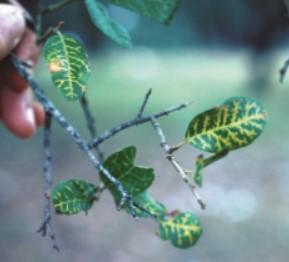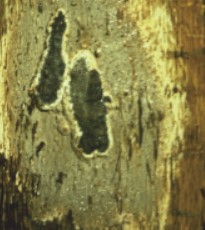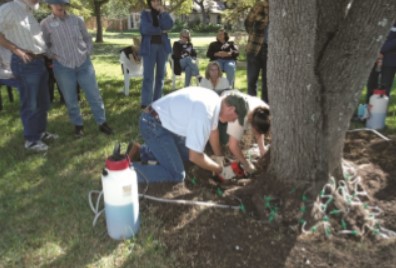
Oak Wilt and the Injection Process

Common symptoms on a Red Oak. Photo by Joseph O'Brien, USDA Forest Service.
Published April 1, 2009 By RUSSELL PETERS
THE DISEASE AND IT'S BIOLOGY
Oak Wilt is a vascular wilt disease of Oak trees caused by the fungus Ceratocystis fagacearum. All species of Oaks are susceptible with some species being somewhat tolerant. Red Oaks, both Shumard and Spanish/Texas, are highly susceptible to the pathogen, with Live Oak following a close second.
The disease in Red Oak is expressed in two primary ways.The first is an oily green appearance to sections of the canopy, which rapidly turn a tan color as the foliage dries on the tree.The other and less common expression is a heavy and rapid shedding of foliage with a variety of the above symptoms on fallen leaves. The shedding is fairly uniform throughout the canopy. It is difficult to save Red Oaks once infected, but there is more and more evidence that if the infection is caught soon after it begins to develop, there is a good chance of preserving the remainder of the canopy. The better treatment method is preventing the infection from taking place by injecting the tree with the fungicide Alamo. Red Oaks that have died from Oak Wilt should be removed as soon as possible as these species are responsible for the overland spread of the pathogen.

Common symptoms on a Live Oak. Photo by William M. Clesia, Forest Health Management International.
There are a variety of possible foliar symptoms observed in infected Live Oaks. The most common is termed veinal necrosis (yellowing and browning of the main leaf vein and side veins.) The foliage will usually fall once this symptom has appeared. It is possible to see leaves still on the tree with veinal necrosis. The defoliation in Live Oak can occur at anytime of the year, but should not be confused with the normal process of leaf drop and flowering that generally occurs late February to late March. Like the Red Oaks, treatment of trees showing symptoms of Oak Wilt are not always savable. Prevention with Alamo injections are the best use of the treatment.
The disease spreads from tree to tree in two methods. The first and most common is root-to-root contact. It is well known that some species of trees can form functional root grafts with other trees. Once the pathogen has entered a tree, it can potentially move from tree to tree quite readily and efficiently. This is why it is recommend to inject all Oaks on the property found within 100 to 150 linier feet of symptomatic trees or protective purposes
The second method of disease transmission is overland spread. This occurs when fungal mats are produced on dying Red Oaks and visited by the suspected insect vector, the Nitidulid Sap Feeding Beetle.

Fungal mats on an infected Red Oak. Photo by Fred Baker, Utah State University.
It should be noted that fungal mats are produced primarily in the spring or cooler times of the year and only form on Red Oaks at a particular phase of mortality. Mats will be producing viable spores of the fungus, for a short period of time. This time frame is usually two to three weeks at the most.
Although new infection centers do form from time to time, it is not fully understood whether it is from the insect spreading the disease or possibly other methods of transmission such as infected pruning tools, squirrel damage during the spring, or methods not yet discovered.
THE ROOT FLARE INJECTION PROCESS
The root flare injection process is three fold. The first is to expose the buttress roots or root flare of the tree or trees being injected. This is accomplished with careful excavation of the base of the tree where plant material and soil are removed from around the base of the tree with an airspade and/or a shovel. The distance away from the trunk in which plant material and soil will need to be removed will vary according to the size or diameter of the tree being treated.

Macro-injection of Alamo fungicide. Photo by Ronald F. Billings, Texas Forest Service.
The second step is to physically perform the high volume root flare injection with the fungicide Alamo. It is available in a water-soluble formulation, which will have a distinct blue color.
A series of holes will be drilled up and down the exposed root flares at about four to six inch increments. Proper location of these injection sites is critical for proper distribution of the fungicide. Inadequate distribution leaves trees poorly protected. A series of injection tees are inserted into the injection sites and connected with tubing to create a closed system. The system is usually attached to a pressure tank containing the fungicide solution and the injection process begins. Once the tree has taken up the allotted amount of fungicide, the application equipment is removed from the tree.
The third step is to refill the exposed root flare area that was excavated in the first step if needed. There are instances where trees have been planted too deep to begin with, or fill soil has been added. In these cases it is recommend to fill with river rock or leave the root flare exposed entirely. Each situation will differ and your arborist will recommend what is best for the long term health of the tree.
In general, Live Oaks and Red Oaks not expressing active disease symptoms are good candidates for preventive root flare injection with the fungicide. But it appears that Oaks can be infected with the fungus up to a year before active symptoms are expressed. What this means is that an apparently healthy Oak adjacent to a diseased tree may already be infected and in this instance, uptake of the fungicide may be poor.
Treatment with Alamo is not a one time application. The fungicide dissipates over time and the trees must be re-treated once every 18 to 24 months. Field tests have shown this schedule varies depending on the surrounding area and tree. Your arborist will set up an inspection program and alert you when retreatment is needed.
If I keep my trees healthy will they be less susceptible to infection by the Oak Wilt fungus?
No, unfortunately this is not the case. The Oak Wilt pathogen is an aggressive vascular wilt disease and Oak trees are genetically predisposed to infection by the fungus. To draw an analogy, the Chicken Pox Virus does not infect only children who are unhealthy. Healthy children still get the infection at some time or another because humans are genetically predisposed to the Chicken Pox Virus.
How fast does the disease spread in a population of Oak trees?
The disease has been reported to move 100 to 150 linier feet per year in a solid stand of Oaks. This can vary greatly due to each site's unique characteristics.
Which trees should I treat?
Your arborist will generally recommend treating all Oaks on the property, and certainly all that potentially could form root grafts. This will vary from site to site and will usually not include trees already showing active symptoms.
Should my neighbor treat their trees?
Because this disease can travel 100 to 150 linier feet per year to susceptible Oak species, it is important your neighbors contact a certified arborist for treatment recommendations. The best candidates for preventive injection are those Oaks out ahead of the active disease center. Treating trees that are symptomatic or possibly already infected have a lesser chance of survival.
Does it matter how much fungicide the tree receives?
It is critical that the tree receives a minimum of 12 milliliters of Alamo for every inch in diameter. This diameter measurement is usually taken at DBH (diameter at breast height or four and a half feet above soil grade). Arborilogical Services commonly recommends 20 milliliters per inch for larger trees (over 24” in diameter) being injected or if high disease pressure exists.
Is this injection process guaranteed?
The process has no guarantees, but injections are most successful when the trees being treated are not showing active symptoms and are some distance from infected trees. There can still be failures from time to time, which are usually due to the tree already being, infected which leads to poor uptake and distribution.
Why does the process seem expensive?
The cost of the process is primarily driven from the cost of the fungicide and the extensive labor involved in preparing the injection site, the application, and the return visit to collect the equipment and re-cover the excavated roots if needed.
Will the root flare injection ever need to be repeated?
Once trees are injected, it appears they are protected for about two years. If the disease pressure is high, that is to say the Oak Wilt center is still active next door or across the street, your arborist may recommend retreating the following year. When treating trees with active symptoms and the symptoms reappear the following season, it is commonly recommend to retreat. Retreating high value, unique, or historic trees annually as a preventative is not unusual.
Are there alternative methods for the prevention of Oak Wilt?
Yes, but macro-injection with Alamo is the only proven successful treatment and prevention. There are a few other methods currently on the market, but they are experimental and will take a number of years to provide adequate data.

